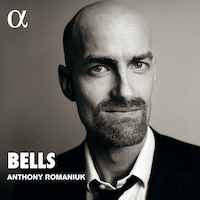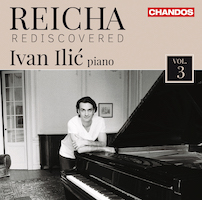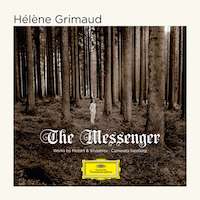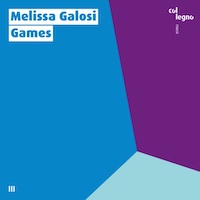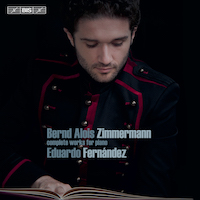Piano Factory 28.
|
Grant Chu Covell [February 2021.]
“Bells.” Béla BARTÓK: Bagpipe Music from Mikrokosmos, Book V (1926-39); Pê-loc from Romanian Folk Dances (1915). J.S. BACH: Prélude and Bourreé from English Suite No. 2 in A minor, BWV 807 (1715-20). Claude DEBUSSY: Voiles from Préludes, Book I (1909-10). György LIGETI: Cantabile from Musica Ricercata (1951-53). William BYRD: The Bells (1590). George CRUMB: Twin Suns from Makrokosmos, Vol. 2 (1973). Ludwig van BEETHOVEN: No. 4 from Bagatelles, Op. 126 (1825); Rondo from Sonata No. 15 in D major, Op. 28 (1801). Federico MOMPOU: No. 5 from Musica Callada, Book I (1959); No. 13 from Musica Callada, Book II (1962). W.A. MOZART: Adagio in B minor, K. 540 (1788). Chick COREA: Children’s Song (1984). Jean-Philippe RAMEAU: Musette en rondeau from Pièces de clavessin (1724). ANONYMOUS: Orlof, Vrauwe, Ende lc Moet Gaen (ca. 1300). Henry PURCELL: Fantasia upon One Note in F Major (1680). Anthony ROMANIUK: Var. Improvisations (2019). Dmitri SHOSTAKOVICH: Prelude and Fugue No. 1 in C Major, Op. 87, No. 1 (1950-51). Anthony Romaniuk (pno, fortepiano, hpsi, Fender Rhodes). Alpha 631 (1 CD) (www.outhere-music.com). Romaniuk’s eclectic tour explores different realizations of bells (or drones). He uses four instruments, piano, fortepiano, harpsichord and a Fender Rhodes, passing through time with improvisations to set the mood. Tracks by Byrd, Purcell, Mompou and Ligeti most evidently align with Romaniuk’s objective, whereas the connection with Crumb, Debussy and Shostakovich is harder to parse. Romaniuk executes improvisations at the start of several pieces and two standalones: one you might hear played on a kora (on harpsichord) and another exploring Schubert’s Der Leiermann (on fortepiano). Not every item hits home. The Presto from Op. 126 is hurried and blurry at 3:30, whereas the conclusion to the Pastorale sonata is just right. My favorite track – actually, a revelation – is the Prelude from Bach’s Second English Suite, BWV 807, which glows fantastically on Fender Rhodes. I’ve had this on repeat more than once. Gentle and boppy, but slightly acidic, Bach’s design never sounded so clear.
“Reicha Rediscovered. Vol. 3.” Antoine REICHA: L’Art de Varier, Op. 57 (1802-03). Ivan Ilić (pno). Chandos 20195 (1 CD) (www.chandos.net). Between Bach’s Goldbergs and Beethoven’s Diabellis, hides a less frequently heard variation set. Bach may have had Buxtehude’s La Capricciosa to guide him; Beethoven may have had Reicha’s Op. 57 at hand. Arriving at Volume 3 in his survey (Vol. 1 was mentioned here), Ilić illuminates one of Reicha’s more famous yet obscure compositions. The tune may not be profound, but it is simple to memorize with distinctive melodic, rhythmic and harmonic shapes. Reicha generally alternates slow and fast, the speedier variations becoming etudes involving trills, arpeggios, rapid octaves, technical exercises, etc. What keeps the 90-minute flow interesting is that within a variation’s first phrase Reicha often suggests two paths making it hard to predict what he will do in its second half. There are surprises among the set of 57 (yes, Op. 57 consists of 57 variations). Var. 5 changes the meter at each bar (though it’s only common time, 3/4 and 2/4). Var. 29 keeps the melody but harmonizes with surprise modal chords, anticipating Schubert and Satie. Var. 50’s chromaticism again foreshadows late Schubert. Even if there are further volumes this will stand as a highpoint.
“Encounter.” J.S. BACH: 10 Chorale Preludes (1705-48; arr. Ferruccio BUSONI, 1898). Johannes BRAHMS: 6 Chorale Preludes, Op.122 (1896; arr. F. BUSONI, 1897); Vier ernste Gesänge, Op. 121 (1896; arr. Max REGER, 1912). Max REGER: Nachtlied, Op. 138, No. 3 (1914; arr. Julian BECKER). Morton FELDMAN: Palais de Mari (1986). Igor Levit (pno). Sony 194397865721 (2 CDs) (www.sonyclassical.com). Reflecting upon his performance activities in 2020 quarantine, Levit shares a contemplative program, anchored with transcriptions of religious music. Busoni’s beefy arrangements of Bach and Brahms’ organ music are simultaneously translations and commentary. To simulate pedals, Busoni asks for low octaves (Nun komm, der Heiden Heiland); elsewhere he delineates lines so that melodies emerge crisply (the famed Wachet auf, ruft uns die Stimme). The Brahms Chorales are beloved, but rare. Busoni and Reger’s interpretations bring them to the piano, but do not make them easier fare. Reger is not thought of as a light touch or miniaturist, but this piano arrangement of a chorus prompts a second glance. Transferred to piano, there are chord sequences that suggest Satie. Levit concludes with Feldman who studied piano with Vera Maurina-Press who in turn studied with Busoni. Palais de Mari is lightly scented sorbet after multiple courses of rich stews and sauces. We step away from thick Germanic piety towards Zen-like naturalism, from weighty chords and counterpoint to treble repetitions and frail shapes. But Levit’s Feldman satisfies the same need for contemplation and togetherness that we receive from a Bach Chorale.
“The Messenger.” W.A. MOZART: Fantasia in D minor, K. 397 (1782)1; Piano Concerto No. 20 in D minor, K. 466 (1785; cadenzas by Ludwig van BEETHOVEN, 1809)2; Fantasia in C minor, K. 475 (1785)3. Valentin SILVESTROV: The Messenger – 1996 for piano and strings (1996-97)4; Two Dialogues with Postscript (2001-02)5; The Messenger – 1996 for piano (1996-97)6. Hélène Grimaud1,2,3,4,5,6 (pno), Camerata Salzburg2,4,5. DG 00289 483 7853 (1 CD) (www.deutschegrammophon.com). Mozart and Silvestrov make for obvious discmates, however, doing so unfairly dilutes Silvestrov’s nostalgic impact. These Mozart selections are forward looking: Grimaud steers the unstructured D-minor Fantasia towards the solemn same-key Concerto (with Beethoven’s cadenzas), and the C-minor Fantasia slips effortlessly into the ensemble version of The Messenger, an ethereal valediction which Silvestrov wrote after the death of his wife, Larissa Bondarenko. The three-part Two Dialogues with Postscript overtly incorporates Schubert and Wagner, and echoes K. 475. Less explicitly, The Messenger recalls Mozart’s glass harmonica pieces which a casual listener might hear as a sickly Mozart arrangement. Silvestrov’s profoundly skillful employ of Mozartian gesture should charm an attentive listener. Despondent and unresolved, The Messenger is decidedly modern. Grimaud probes for answers, past and present.
“Games.” W.A. MOZART: Zwölf Variationen, “Ah, vous dirai-je, Maman,” K. 265 (1781/82); Zehn Variationen, “Unser dummer Pöbel meint,” K. 455 (1784); Zwölf Variationen, K. 500 (1786). György KURTÁG: Selections from Játékok (1973-present). Melissa Galosi (pno). col legno CL3 1CD 15001 (1 CD) (www.col-legno.com). Hardly child’s play, Galosi delightfully juxtaposes clustered Mozart variations with Kurtág pieces. The interleaved sequence does not jar as much as one would expect. Let’s remember that Kurtág’s intent with Játékok was to recreate a child’s sense of wonder on her first discovery of the piano. The first three Játékok volumes are for beginners; the subsequent books (there are now nine) are more advanced (and also include pieces for piano four hands and multiple pianos). We hear several Mozart variations in sequence, a few Kurtág selections, and then Mozart continues. The Classical threads are not lost among Kurtág’s bracing homages, memorials and greetings. The ear does play tricks when the Alberti bass of Grassblades follows the fifth variation of K. 500. I don’t think I’ve ever listened as closely to the Twinkle, Twinkle variations.
Bernd Alois ZIMMERMANN: Drei frühe Klaviertstücke (1939-46); Extemporale (1946); Capriccio (1946); Enchiridion I (1949); Enchiridion II (1951); Enchiridion – Anhang (1949-51); Konfigurationen (1956). Eduardo Fernández (pno). BIS BIS-2495 (1 SACD) (www.bis.se). Zimmermann’s piano works disclose a preoccupation with balance, whether dark vs. light, serious vs. capricious, or, ultimately, life vs. death. At this collection’s center is the 11:38 Capriccio, an impulsive camouflaged examination of children’s tunes. We may not catch all the melodies but should be able to scout out Zimmerman’s transformational techniques. Dances lurk among the early triptych and Extemporale’s less ironically dressed five (although the latter’s Bolero requires teasing out). The mature Enchiridion groupings (each is a “handbook” meant to “provide material for practice”) are suites obscurely flavored with dances. The second group grows sparser, even if it is meant to explore expression and keyboard technique. These 1949-51 collections reveal Zimmermann approaching polystylism. Serialism is kept at bay, but perky rhythms recall Stravinsky. The eight miniatures in Konfigurationen announce a composer who knows precisely what serialism can do for him: abrupt contrasts, brittle single points, suggestions of larger shapes. Fernández adeptly conveys Zimmermann’s mocking universe.
BA Zimmermann, Bach, Bartók, Beethoven, Brahms, Busoni, Byrd, Corea, Crumb, Debussy, Feldman, J Becker, Kurtág, Ligeti, Mompou, Mozart, Purcell, Rameau, Reger, Reicha, Romaniuk, Shostakovich, Silvestrov
[More Grant Chu Covell, Piano Factory]
[More
BA Zimmermann, Bach, Bartók, Beethoven, Brahms, Busoni, Byrd, Corea, Crumb, Debussy, Feldman, J Becker, Kurtág, Ligeti, Mompou, Mozart, Purcell, Rameau, Reger, Reicha, Romaniuk, Shostakovich, Silvestrov]
[Previous Article:
Pièces de Clavecin 12: Old and New]
[Next Article:
Used Bin Troll Tweets WW.]
|
